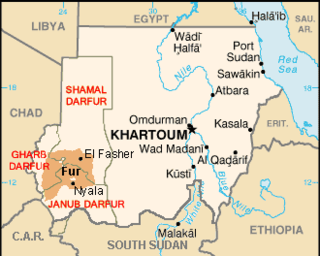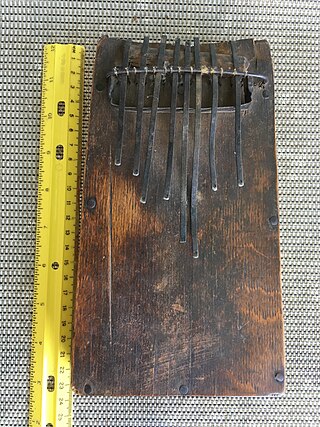Related Research Articles

The Nilo-Saharan languages are a proposed family of African languages spoken by somewhere around 70 million speakers, mainly in the upper parts of the Chari and Nile rivers, including historic Nubia, north of where the two tributaries of the Nile meet. The languages extend through 17 nations in the northern half of Africa: from Algeria to Benin in the west; from Libya to the Democratic Republic of the Congo in the centre; and from Egypt to Tanzania in the east.
In linguistics, singulative number and collective number are terms used when the grammatical number for multiple items is the unmarked form of a noun, and the noun is specially marked to indicate a single item.

The Fur language is a Nilo-Saharan language spoken by the Fur of Darfur in Western Sudan. It is part of a broader family of languages known as the Fur languages.
Shabo is an endangered language and likely language isolate spoken by about 400 former hunter-gatherers in southwestern Ethiopia, in the eastern part of the South West Ethiopia Peoples' Region.
Anfillo is a Northern Omotic language spoken in western Ethiopia by a few hundred people. The term Anfillo is used to refer both to the language and the people found in a small community in the Anfillo woreda, part of the Mirab Welega Zone. The language is on the verge of extinction as it is spoken only by adults above the age of sixty. All younger generations have shifted to Western Oromo as of 2007.

The Mursi are a Surmic ethnic group in Ethiopia. They principally reside in the Debub Omo Zone of the Southern Nations, Nationalities, and People's Region, close to the border with South Sudan. According to the 2007 national census, there are 11,500 Mursi, 848 of whom live in urban areas; of the total number, 92.25% live in the Southern Nations, Nationalities, and People's Region (SNNPR).
The Surmic languages are a branch of the Eastern Sudanic language family.

The Murle are a Surmic ethnic group inhabiting the Pibor County and Boma area in Greater Pibor Administrative area, South Sudan, as well as parts of southwestern Ethiopia. They have also been referred as Beir by the Dinka and as Jebe by the Luo and Nuer, among others. The Murle speak the Murle language, which is part of the Surmic language family. The language cluster includes some adjoining groups in Sudan, as well as some non-contiguous Surmic populations in southwestern Ethiopia.
Meʼen is a Nilo-Saharan language spoken in Ethiopia by the Meʼen people. In recent years, it has been written with the Geʽez alphabet, but in 2007 a decision was made to use the Latin alphabet. Dialects include Bodi (Podi) and Tishena.
The Gumuz are an ethnic group speaking a Nilo-Saharan language inhabiting the Benishangul-Gumuz Region in western Ethiopia, as well as the Fazogli region in Sudan. They speak the Gumuz language, which belongs to the Nilo-Saharan family. The Gumuz number around 250,000 individuals.
The Tennet people are South Sudanese. Their language is sometimes referred to as Ngaarit. Tennet traditional dances are divided into the following categories: Lalu, Nyaliliya, Loduk, and so on
Mursi is a Southeast Surmic language spoken by the Mursi people who live in the South Omo Zone on the eastern side of the lower Omo valley in southwest Ethiopia. The language is similar to Suri, another Southeast Surmic language spoken to the west of the Mursi language area. It is spoken by approximately 7,400 people.

The Majang people, or Majangir, live in southwestern Ethiopia and speak a Nilo-Saharan language of the Surmic cluster. The 1998 census gave the total of the Majangir population as 15,341, but since they live scattered in the hills in dispersed settlements, their actual total number is undoubtedly much higher. They live around cities of Tepi, Mett'i, and scattered southwest of Mizan Teferi and towards Gambela.

The Majang language is spoken by the Majangir people of Ethiopia. Although it is a member of the Surmic language cluster, it is the most isolated one in the group. A language survey has shown that dialect variation from north to south is minor and does not seriously impede communication. The 2007 Ethiopian Census lists 6,433 speakers for Majang (Messengo), but also reports that the ethnic group consists of 32,822 individuals. According to the census, almost no speakers can be found in Mezhenger Zone of Gambela Region; a total of eleven speakers are listed for the zone, but almost 10,000 ethnic Mejenger or Messengo people.
The Aroid or Ari-Banna languages possibly belong to the Afro-Asiatic family and are spoken in Ethiopia.
The Baale language, Baleesi or Baalesi is a Surmic language spoken by the Baale or Zilmamo people of Ethiopia, and by the Kachepo of South Sudan. It is a member of the southwest branch of the Surmic cluster; the self-name of the language and the community is Suri, which is the same as that of the Suri language, evoking an ethnonym that embraces the Tirma, Chai, and Baale communities, although linguistically the languages of these communities are different. There are currently 9,000 native speakers of Baleesi, 5,000 in South Sudan and 4,100 in Ethiopia; almost all of these are monolingual.
Suri, is a Surmic language spoken in the West Omo Zone of the South West Ethiopia Peoples' Region in Ethiopia, to the South Sudan border by the Suri. The language has over 80% lexical similarity to Mursi. The language is often referred to by another form of its name, Surma, after which the Surmic branch of Eastern Sudanic is named, but that form is frequently used for the three related languages spoken by the Surma people: Suri, Mursi, and Me'en.
´Bëlï, or Jur Beli, is a Central Sudanic language spoken by the Beli and Sopi people of South Sudan. The Beli people are mainly found in South Sudan, a region southeast of Rumbek. The language is considered as endangered, and it is mostly spoken by the older generation.
Tennet is a Surmic language spoken by the Tennet people in South Sudan. The Tennet home area is a group of fifteen (15) villages at the northern part of Eastern Equatoria state, 65 kilometers northeast of Torit.
Gumuz is a dialect cluster spoken along the border of Ethiopia and Sudan. It has been tentatively classified within the Nilo-Saharan family. Most Ethiopian speakers live in Kamashi Zone and Metekel Zone of the Benishangul-Gumuz Region, although a group of 1,000 reportedly live outside the town of Welkite. The Sudanese speakers live in the area east of Er Roseires, around Famaka and Fazoglo on the Blue Nile, extending north along the border. Dimmendaal et al. (2019) suspect that the poorly attested varieties spoken along the river constitute a distinct language, Kadallu.
References
- ↑ Murle at Ethnologue (25th ed., 2022)

- ↑ (Arensen 1982)
- ↑ Arensen, Jon, Nicky de Jong, Scott Randal, Peter Unseth. 1997. "Interrogatives in Surmic Languages and Greenberg's Universals", Occasional Papers in the Study of Sudanese Languages 7:71–90.
- ↑ Payne, Thomas (2006). Exploring language structure : a student's guide . Cambridge, UK New York: Cambridge University Press. pp. 44, 45. ISBN 0-521-67150-7.
- ↑ p. 124; Bender, M. Lionel. 1983. Majang phonology and morphology. In Nilo-Saharan Language Studies, ed. by M. Lionel Bender, 114-147. East Lansing: Michigan State University.
- ↑ p. 86. Unseth, Peter. 1988. Majang nominal plurals, with comparative notes. Studies in African Linguistics 19.1:75-91.
- ↑ Bryan, Margaret. 1959. The T/K languages: A new substratum. Africa 29:1-21.
- ↑ Yigezu, Moges (2005). Aspects of Murle phonology. In Journal of Ethiopian Studies XXXVIII. pp. 115–129.
{{cite book}}: CS1 maint: location missing publisher (link)